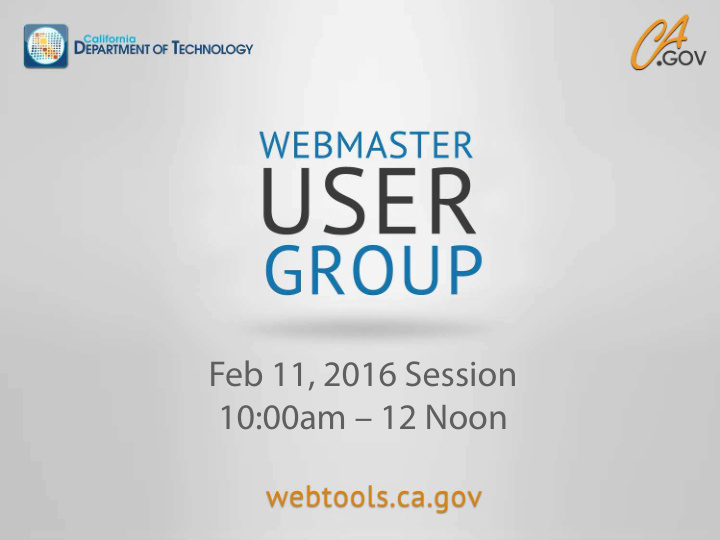



Feb 11, 2016 Session 10:00am – 12 Noon
Agenda Topic Presenter / Facilitator Timeframe Welcome Michael Chen 2 min. • Web Accessibility Patrick Johnson 30 min. • New Accessibility Mandates David Escobar 25 min. • State Template Follow-Up Artem Khomishen 20 min. • Open Data Scott Gregory 40 min. • Closing Michael Chen 2 min. • 2
Web Accessibility Facilitator: Patrick Johnson
Web Accessibility Answ ering Questions February 11, 2016
Introduction: Patrick Johnson Webmaster, Department of Rehabilitation(1996) Phone: (916) 558-5873 Email: Patrick.L.Johnson@dor.ca.gov Or: webmaster@dor.ca.gov (mostly me)
Update on Section 508 of The Rehabilitation Act • 2018 – DOJ has delayed the Access Board’s update to 508 • To allow time for agencies to prepare • February 2014 - Proposed rule w as submitted for review Office of Management and Budget (OMB) • To reflect W3C WCAG 2.0 AA • Court Cases around the ADA and WCAG 2.0
What are the differences betw een WCAG 1.0 and WCAG 2.0? • The WCAG 2.0 requirements are more precisely testable. • WCAG 1.0 is organized around guidelines that have checkpoints. • WCAG 2.0 is organized around four design principles of Web accessibility (Perceivable, Operable, Understandable, and Robust). Each principle has guidelines , and each guideline has testable success criteria.
Example: WCAG 1.0 Check point 1.1 talks about “Providing a text • equivalent for every non-text element…” WCAG 2.0 Check point 1.1.1 talks about “Non-text • Content: All non-text content that is presented to the user has a text alternative that serves the equivalent purpose, except for the situations listed below. Controls, Input… • Time-Based Media… • Test… • Sensory… • CAPTCHA… • Decoration, Formatting, Invisible… •
So w hat do w e w atch out for? • Server-side image maps are not keyboard accessible. If used, provide additional text links somew here else on the • page to the same place/information. • Contrast (Minimum): The visual presentation of text and images of text has a contrast ratio of at least 4.5:1 (WCAG 1.0 w as about 5:1), except for the follow ing: Large Text: Large-scale text (18 point or 14 point bold) and • images of large-scale text have a contrast ratio of at least 3:1 w hen delivered. Incidental: Text or images of text that are part of an inactive • user interface component, that are pure decoration, that are not visible to anyone, or that are part of a picture that contains significant other visual content, have no contrast requirement. Logotypes: Text that is part of a logo or brand name has no • minimum contrast requirement. • Make sure your elements have complete start and end tags. • The purpose of each link can be determined from the link text alone.
So w hat do w e NOT have to w atch out for? User agents now render text alternatives for • client-side image map areas. Providing summaries for tables is no longer • required for conformance. Flashing content is allow ed now – How ever, they • cannot flash more than three times in any one second period, and user should be able to stop, pause or hide the item. Scrolling content is allow ed now – How ever, the • user should be able to stop, pause or hide the item.
Keyboard Traps DO NOT DO THIS – But, w hat are they? • Javascript – Example • $(document).ready(function(){ • $(‘a.trap’).keydow n(function(event){ • event.preventDefault(); • var href = $(this).attr(‘href’); • var text = $(this).text();; • w indow.open(href, text); • }); • }); • In this example, the keydow n event has been used to open a new • w indow (this in itself is bad for accessibility but w e w ill ignore this for now ). When a person using a keyboard attempts to move focus aw ay from the link show n in the example, the keydow n event w ill be triggered and the resulting function w ill be executed. Flash • iOS •
Web Accessibility Open Forum
New Accessibility Mandates Facilitator: David Escobar
TL 15-05 November 2015 The purpose of this Technology Letter (TL) is to remind all Agency/state entities of the statutory requirements related to web accessibility and to provide information to assist in immediate implementation: California State agencies must design and develop web content that is accessible to people with disabilities as well as those without disabilities 14
TL 15-05 November 2015 The purpose of this Technology Letter (TL) is to remind all Agency/state entities of the statutory requirements related to web accessibility and to provide information to assist in immediate implementation: Web page developers, designers, programmers, and content providers must become familiar with the standards and guidelines for achieving universal Web accessibility and must comply with applicable Web Accessibility Laws as described in the SIMM Section 25 15
TL 15-05 November 2015 The purpose of this Technology Letter (TL) is to remind all Agency/state entities of the statutory requirements related to web accessibility and to provide information to assist in immediate implementation: As of July 1, 2016, all public facing websites maintained by California state Agencies/state entities shall include standard browser usability features and links to additional pertinent information on their web site’s homepage. The hyperlink may be placed in the header or footer and be consistently applied to all web pages. The hyperlink should not be included in any slideshow or rotating carousel display 16
TL 15-05 November 2015 Instructions to assist Agencies/state entities to comply with this requirement and methods by which they can conduct web accessibility testing can be found at: 17
http://webtools.ca.gov/web-content/web-accessibility/ 18
State Template Follow-Up Facilitator: Artem Khomishen
Open Data Facilitator: Scott Gregory
Thanks for Coming! Contact: Info.Eservices@state.ca.gov 22
Recommend
More recommend